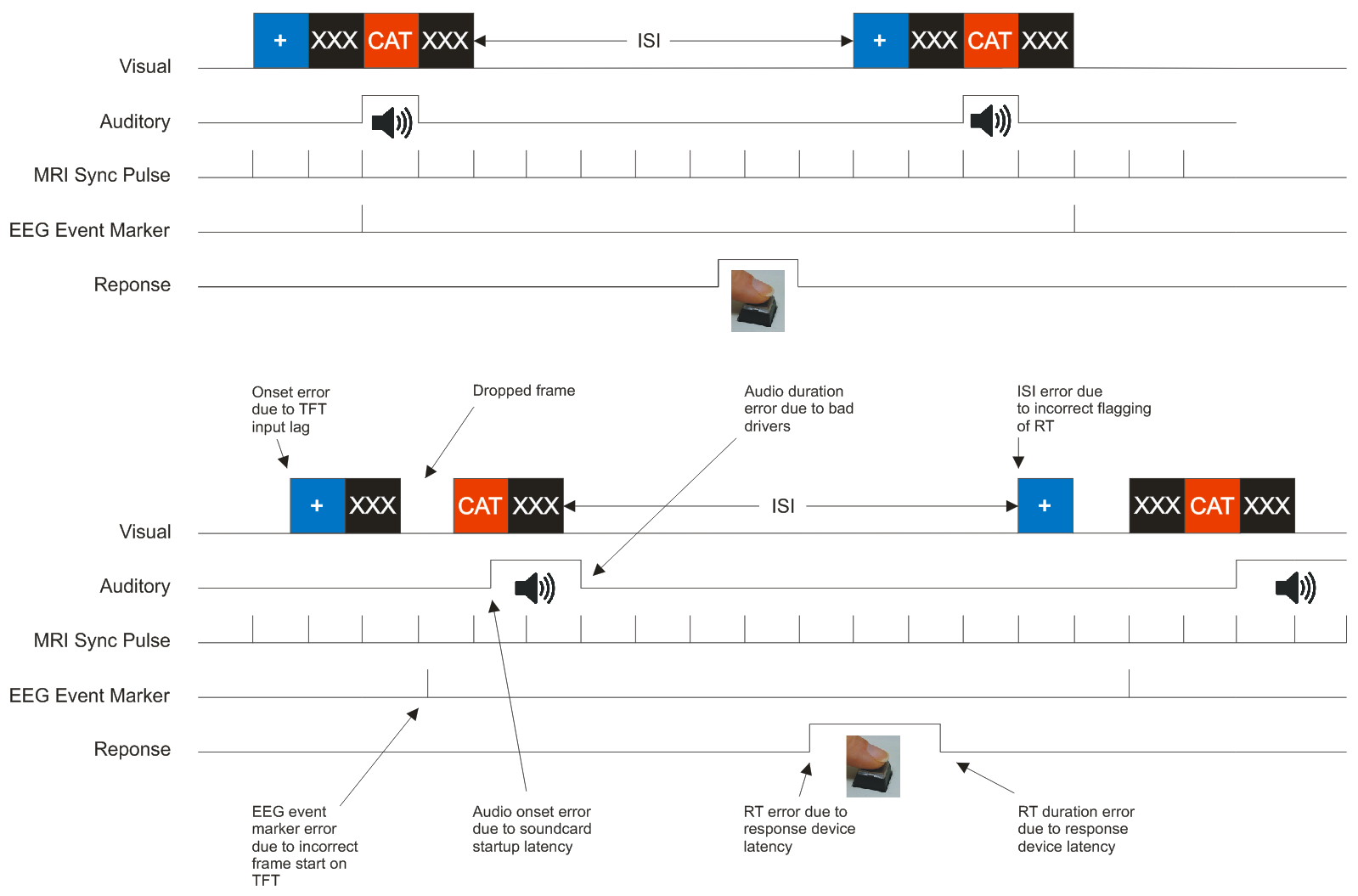Background
Psychologists, neuroscientists and vision researchers regularly make use of computer-based experiments. Most assume that the computer accurately presents stimulus materials and records responses as programmed with millisecond accuracy. However testing has shown this expectation is often misplaced. Presentation, synchronization and response timing errors can be caused by many factors. Whether you make use of a commercial experiment generator or write custom software, you are likely to succumb to such errors. Inconsistent timing can lead to spurious conditional effects, poor replicability and bad science.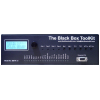

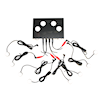
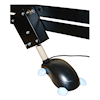
The Black Box ToolKit v3™ key features

 Typically
the BBTK v3 operates as a virtual human programmed to respond to
stimulus presentations and generate appropriate responses very
accurately. It can step through your whole experiment as if it was
a human participant. External sensors are hooked up to a second
PC, Mac or Linux box to detect stimulus presentations and a
generation interface is used to feed a response into the paradigm
under test. The BBTK v3 measures the timing of all stimulus,
synchronization and response events extremely accurately, allowing
you to compare timing measured by your own equipment with the
actual real world timings. The BBTK v3 can also work with up to 20
I/O TTL lines/TTL triggers when used in fMRI studies, for EEG or
eye tracking. Show
me a worked example.
Typically
the BBTK v3 operates as a virtual human programmed to respond to
stimulus presentations and generate appropriate responses very
accurately. It can step through your whole experiment as if it was
a human participant. External sensors are hooked up to a second
PC, Mac or Linux box to detect stimulus presentations and a
generation interface is used to feed a response into the paradigm
under test. The BBTK v3 measures the timing of all stimulus,
synchronization and response events extremely accurately, allowing
you to compare timing measured by your own equipment with the
actual real world timings. The BBTK v3 can also work with up to 20
I/O TTL lines/TTL triggers when used in fMRI studies, for EEG or
eye tracking. Show
me a worked example.- Set-up – Hook up external stimulus sensors (opto-detectors, mics, TTL) and a response device (response pad, robotic key actuator, sounder, TTL)
- Test – Use a wizard to select a stimulus pattern to automatically respond to/event mark. Then choose the exact reaction time, response device and duration
- Analyze – Check your stimulus, response and synchronization timings across up to 36 channels. Compare what your experiment recorded with what the BBTK saw
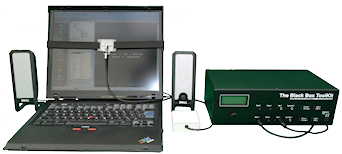 The BBTK v3 also lets you tune
your experiment generators accuracy in a particular study by
automatically simulating a human participant that is millisecond
accurate. This enables you to modify onsets, delays and RTs so
that they are accurate in the real world. Remember the BBTK v3 is
a dedicated self-contained hardware device that is designed to
record stimulus onsets and reaction times in the real world as
they occur with sub-millisecond accuracy. Simple to use with a
range of external sensors. For a fit and forget solution for event
marking be sure to check out our new mBBTK
v3 (event marking version).
The BBTK v3 also lets you tune
your experiment generators accuracy in a particular study by
automatically simulating a human participant that is millisecond
accurate. This enables you to modify onsets, delays and RTs so
that they are accurate in the real world. Remember the BBTK v3 is
a dedicated self-contained hardware device that is designed to
record stimulus onsets and reaction times in the real world as
they occur with sub-millisecond accuracy. Simple to use with a
range of external sensors. For a fit and forget solution for event
marking be sure to check out our new mBBTK
v3 (event marking version).Wizard driven software makes benchmarking and calibrating your experiments timing quick and easy. For example, to check visual stimulus and RT accuracy simply attach an Opto-detector to your screen, select a real-world RT you would like the BBTK v3 to respond with and compare that with what your experiment presented and recorded. It's as easy as 1, 2, 3!
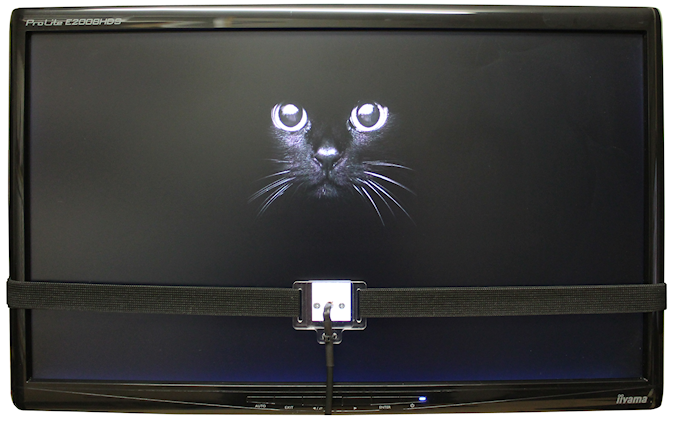
1. Opto-detector placed on black/white block
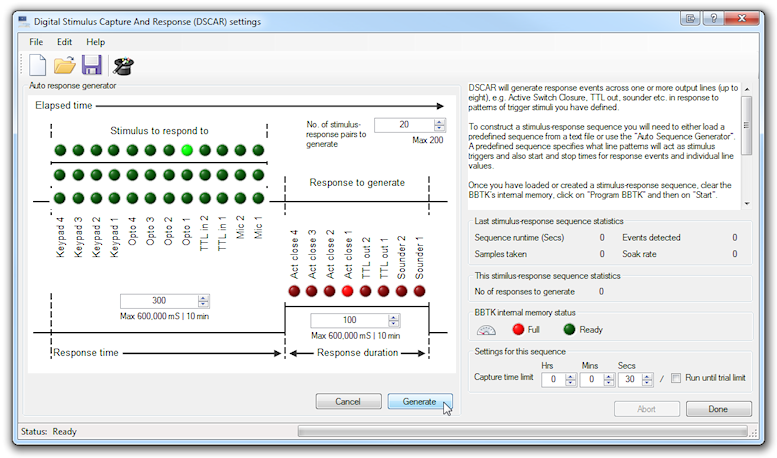
2. Easily enter target timing specifications using a wizard
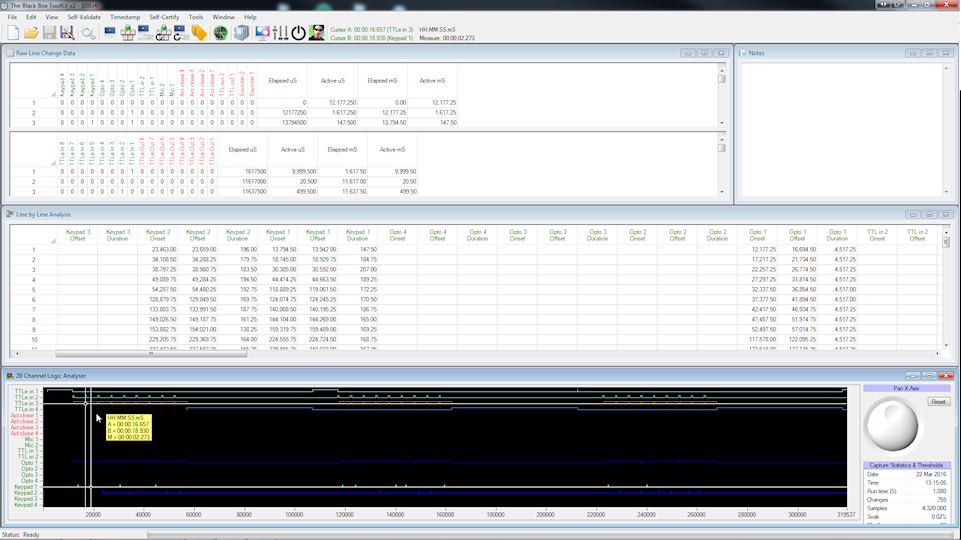
3. The main BBTK v3 interface – analyze timings using the spreadsheets or
use the 20 Channel Logic Analyzer and moveable cursors
Need more complexity in your benchmarking. No problem, just add more sensors to check real-world presentation, synchronization and response timing accuracy. Show me a worked example.
Just some of the causes of replication failure in computer-based psychology experiments are shown in the diagram below. What | Why | How
Idealized experiment shown
top, what may happen on your own equipment bottom (click to
enlarge)
Key features
|
|
Front connectors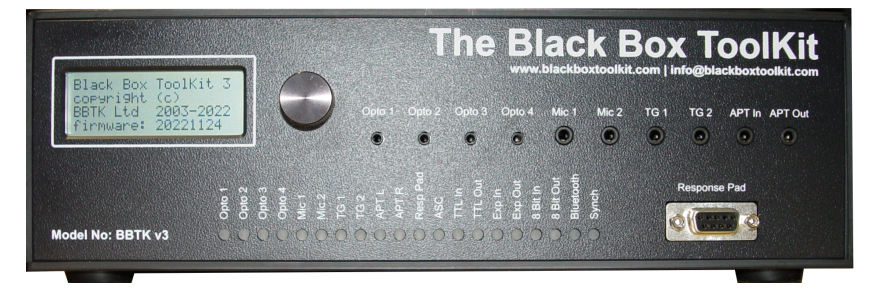
Front
connectors and indicator LEDs
|
Rear
indicator LEDs
|
Rear connectors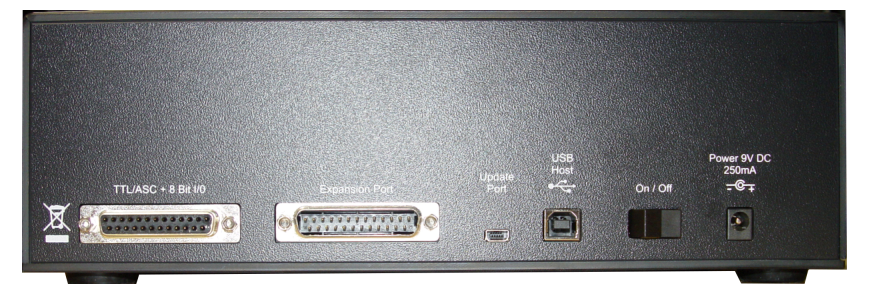
|
|
Sensors, modules & optional extras
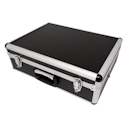
|
High quality aluminum carrying caseProtects your BBTK and additional modules from accidental damage.We strongly recommend you consider purchasing the aluminum carrying case shown to help protect the toolkit and additional modules. |
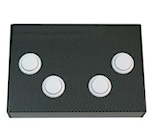
|
Black Box Toolkit USB Response PadSimply plug in to a USB port on your PC/Mac/Linux system and our response box will appear as a second keyboard. Press a button and a standard keystroke will be sent to your experiment. No need for drivers, no need to recode! Works out of the box with E-Prime, SuperLab, Presentation, Inquisit, PsychoPy or any other software that can accept standard keyboard responses. Outputs simultaneously sent to the BBTK v3 for real time monitoring. |
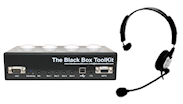
|
Black Box Toolkit USB Response Pad with Voice KeyAll the great features of our standard USB Response Pad but with an integrated voice key. If your participants make a vocal response this also produces a standard key press and TTL event mark/TTL trigger! Simple to use and simple to setup with tunable vocal activation threshold. It's your choice whether to use it as a standard response pad or use it as a voice key. Supplied complete with headset. Outputs simultaneously sent to the BBTK v3 for real time monitoring. |
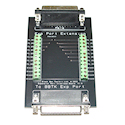
|
16 Channel TTL Breakout BoardBreakout board provides an additional 16 high speed multipurpose TTL lines/TTL triggers (8 input/8 output). Ideal for event marking, synchronization or TTL based response devices.Note: BBTK v3 16 Channel TTL Breakout Boards are NOT compatible and new v3 versions must be used. |
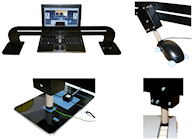
|
Robotic Response Key ActuatorPress keys on your own response devices, e.g. laptop keys, response pads etc. with our robotic finger. Unobtrusive and noninvasive.Can also be used to make responses on devices with either resistive or capacitive touch screens, e.g. Android tablets, iPads, iPhones or other touch screen devices etc. |

|
API & SDK guidePrinted documentation detailing our software API which allows you to control the BBTK v3 from your own applications and decode timing data. The BBTK v3 is controlled via a virtual serial COM port over a USB connection using simple four letter commands. |
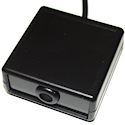
|
BBTK digital microphoneUp to two can be used simultaneously for monitoring for auditory stimulus (adjustable trigger threshold).Note: BBTK v3 microphones are compatible with the new BBTK v3. |
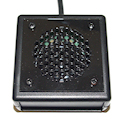
|
BBTK digital sounderUp to two can be used simultaneously for triggering remote voice keys (adjustable for amplitude/volume).Note: BBTK v3 sounders are compatible with the new BBTK v3. |
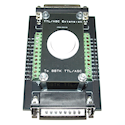
|
25-way ASC/TTL breakout boardAllows for up to 2 TTL out, 2 TTL in and 4 ASC connections to your own equipment. Also includes 4 additional +5V and 8 grounds. Includes calibration button for Robotic response key actuator.Note: BBTK v3 ASC/TTL breakout boards are NOT compatible and new v3 versions must be used. |
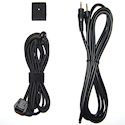
|
Opto-detector sensor and cableUp to four opto-detector sensors can be used with the BBTK v3 to monitor for the appearance of a visual stimulus.Note: BBTK v3 Opto-detector sensors are NOT compatible and new v3 versions must be used. |
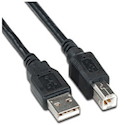
|
Replacement USB host lead (A to B)Used for connecting the base kit to the Host PC. |
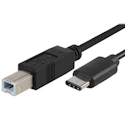 |
USB-C host lead (C to B)Used for connecting the base kit to the Host PC, laptop, tablet or phone. |
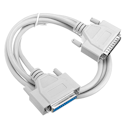
|
Replacement 25-way ASC/TTL breakout board leadUsed for connecting the breakout board to the rear of the BBTK. |
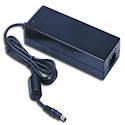
|
Replacement 9V Switch Mode PSU (suitable for international use)Grounded PSU used for powering the BBTK. |
Technical specifications
|
|
Unless otherwise labelled, all products offered for sale by The Black Box ToolKit Ltd are for academic study and/or research use only.

